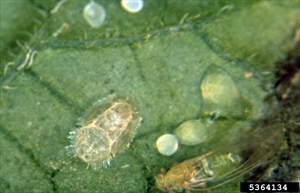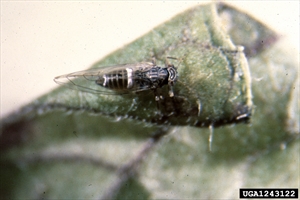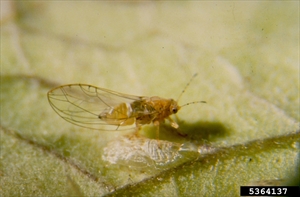-
Widespread. Asia (restricted), Africa (restricted), North and Central America, Europe, Oceania. In New Zealand, Norfolk Islands (external territory Australia). Note, psyllid present in Western Australia, but not the bacterium.
-
Serious bacterial disease of potato and tomato. Also on capsicum, carrots, celery, eggplant, tamarillo, and weeds. Causes stunted plants, yellowing, purpling and cupping of leaves. Stems with internal browning. Dormant buds grow, and aerial tubers form. Fried potato slides show dark brown streaks.
- Eggs, yellow-orange laid in stalks. Nymphs with bodies surrounded by hairs; adults, 2-3 mm long, white bands across first and last abdominal segments, clear wings, tent-like over the body.
- Spread by tomato-potato psyllid, Bactericera cockerelli. Psyllid flies short distances between crops; longer movement of disease by trade in 'seed' potatoes and seedlings. Bacterium passes from female psyllid to eggs.
- Natural enemies: predators and parasitoids identified, but impact not yet well known.
- Biosecurity: important: growers need to monitor for disease and psyllid.
- Cultural control: none.
- Chemical control: neonicotinoid insecticides, e.g., imidacloprid against the psyllid.









